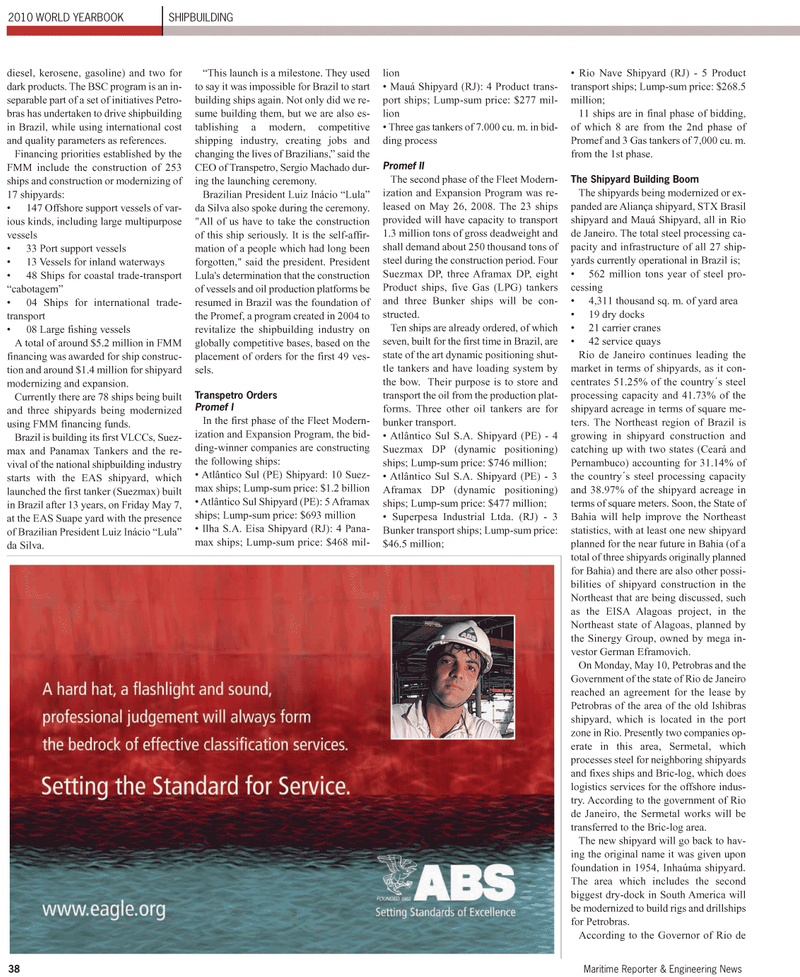
Page 38: of Maritime Reporter Magazine (June 2, 2010)
Read this page in Pdf, Flash or Html5 edition of June 2, 2010 Maritime Reporter Magazine
diesel, kerosene, gasoline) and two for dark products. The BSC program is an in- separable part of a set of initiatives Petro- bras has undertaken to drive shipbuilding in Brazil, while using international cost and quality parameters as references.
Financing priorities established by the
FMM include the construction of 253 ships and construction or modernizing of 17 shipyards: • 147 Offshore support vessels of var- ious kinds, including large multipurpose vessels • 33 Port support vessels • 13 Vessels for inland waterways • 48 Ships for coastal trade-transport “cabotagem” • 04 Ships for international trade- transport • 08 Large fishing vessels
A total of around $5.2 million in FMM financing was awarded for ship construc- tion and around $1.4 million for shipyard modernizing and expansion.
Currently there are 78 ships being built and three shipyards being modernized using FMM financing funds.
Brazil is building its first VLCCs, Suez- max and Panamax Tankers and the re- vival of the national shipbuilding industry starts with the EAS shipyard, which launched the first tanker (Suezmax) built in Brazil after 13 years, on Friday May 7, at the EAS Suape yard with the presence of Brazilian President Luiz Inácio “Lula” da Silva. “This launch is a milestone. They used to say it was impossible for Brazil to start building ships again. Not only did we re- sume building them, but we are also es- tablishing a modern, competitive shipping industry, creating jobs and changing the lives of Brazilians,” said the
CEO of Transpetro, Sergio Machado dur- ing the launching ceremony.
Brazilian President Luiz Inácio “Lula” da Silva also spoke during the ceremony. "All of us have to take the construction of this ship seriously. It is the self-affir- mation of a people which had long been forgotten," said the president. President
Lula's determination that the construction of vessels and oil production platforms be resumed in Brazil was the foundation of the Promef, a program created in 2004 to revitalize the shipbuilding industry on globally competitive bases, based on the placement of orders for the first 49 ves- sels.
Transpetro Orders
Promef I
In the first phase of the Fleet Modern- ization and Expansion Program, the bid- ding-winner companies are constructing the following ships: • Atlântico Sul (PE) Shipyard: 10 Suez- max ships; Lump-sum price: $1.2 billion • Atlântico Sul Shipyard (PE): 5 Aframax ships; Lump-sum price: $693 million • Ilha S.A. Eisa Shipyard (RJ): 4 Pana- max ships; Lump-sum price: $468 mil- lion • Mauá Shipyard (RJ): 4 Product trans- port ships; Lump-sum price: $277 mil- lion • Three gas tankers of 7.000 cu. m. in bid- ding process
Promef II
The second phase of the Fleet Modern- ization and Expansion Program was re- leased on May 26, 2008. The 23 ships provided will have capacity to transport 1.3 million tons of gross deadweight and shall demand about 250 thousand tons of steel during the construction period. Four
Suezmax DP, three Aframax DP, eight
Product ships, five Gas (LPG) tankers and three Bunker ships will be con- structed.
Ten ships are already ordered, of which seven, built for the first time in Brazil, are state of the art dynamic positioning shut- tle tankers and have loading system by the bow. Their purpose is to store and transport the oil from the production plat- forms. Three other oil tankers are for bunker transport. • Atlântico Sul S.A. Shipyard (PE) - 4
Suezmax DP (dynamic positioning) ships; Lump-sum price: $746 million; • Atlântico Sul S.A. Shipyard (PE) - 3
Aframax DP (dynamic positioning) ships; Lump-sum price: $477 million; • Superpesa Industrial Ltda. (RJ) - 3
Bunker transport ships; Lump-sum price: $46.5 million; • Rio Nave Shipyard (RJ) - 5 Product transport ships; Lump-sum price: $268.5 million; 11 ships are in final phase of bidding, of which 8 are from the 2nd phase of
Promef and 3 Gas tankers of 7,000 cu. m. from the 1st phase.
The Shipyard Building Boom
The shipyards being modernized or ex- panded are Aliança shipyard, STX Brasil shipyard and Mauá Shipyard, all in Rio de Janeiro. The total steel processing ca- pacity and infrastructure of all 27 ship- yards currently operational in Brazil is; • 562 million tons year of steel pro- cessing • 4,311 thousand sq. m. of yard area • 19 dry docks • 21 carrier cranes • 42 service quays
Rio de Janeiro continues leading the market in terms of shipyards, as it con- centrates 51.25% of the country´s steel processing capacity and 41.73% of the shipyard acreage in terms of square me- ters. The Northeast region of Brazil is growing in shipyard construction and catching up with two states (Ceará and
Pernambuco) accounting for 31.14% of the country´s steel processing capacity and 38.97% of the shipyard acreage in terms of square meters. Soon, the State of
Bahia will help improve the Northeast statistics, with at least one new shipyard planned for the near future in Bahia (of a total of three shipyards originally planned for Bahia) and there are also other possi- bilities of shipyard construction in the
Northeast that are being discussed, such as the EISA Alagoas project, in the
Northeast state of Alagoas, planned by the Sinergy Group, owned by mega in- vestor German Eframovich.
On Monday, May 10, Petrobras and the
Government of the state of Rio de Janeiro reached an agreement for the lease by
Petrobras of the area of the old Ishibras shipyard, which is located in the port zone in Rio. Presently two companies op- erate in this area, Sermetal, which processes steel for neighboring shipyards and fixes ships and Bric-log, which does logistics services for the offshore indus- try. According to the government of Rio de Janeiro, the Sermetal works will be transferred to the Bric-log area.
The new shipyard will go back to hav- ing the original name it was given upon foundation in 1954, Inhaúma shipyard.
The area which includes the second biggest dry-dock in South America will be modernized to build rigs and drillships for Petrobras.
According to the Governor of Rio de 38 Maritime Reporter & Engineering News 2010 WORLD YEARBOOK SHIPBUILDING

 37
37

 39
39
